British Rail Class 375
| British Rail Class 375 Electrostar | |
|---|---|
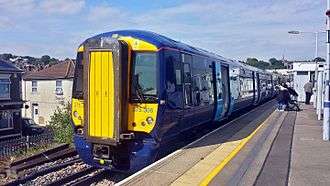 Southeastern 375306 at Strood in 2015 | |
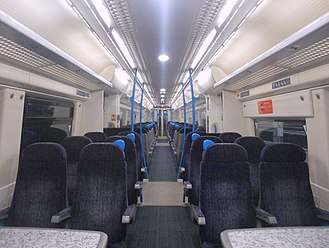 The interior of a refurbished Class 375 | |
| In service | April 2001 - current |
| Manufacturer |
Adtranz / Bombardier Transportation Derby Litchurch Lane Works |
| Family name | Electrostar |
| Replaced | |
| Refurbishment |
|
| Number built | 140 units |
| Number in service |
|
| Formation |
|
| Capacity |
|
| Operator(s) | Southeastern |
| Specifications | |
| Car length | 20.4 m (66 ft 11 in)[1] |
| Width | 2.80 m (9 ft 2 in)[1] |
| Height | 3.78 m (12 ft 5 in) |
| Maximum speed | 100 mph (161 km/h) |
| Weight |
|
| Power output |
|
| Electric system(s) |
|
| Coupling system | Dellner,[2] most units originally had Tightlock couplers when new |
| Track gauge | 1,435 mm (4 ft 8 1⁄2 in) standard gauge |
The British Rail Class 375 is an electric multiple unit train that was built by Bombardier Transportation (previously Adtranz) at Derby Litchurch Lane Works, from 1999 to 2005. The class form part of the Electrostar family of units, which also includes classes 357, 376, 377, 378, 379 and 387, is the most numerous type of EMU introduced since the privatisation of British Rail.
These units form the basis of Southeastern's mainline fleet.
Description
.jpg)
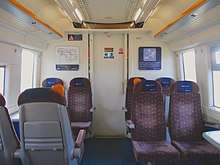
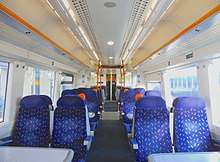
These trains are owned by Eversholt Rail Group (formerly HSBC Rail) and leased to Southeastern for operation from London to Kent and parts of East Sussex.[3]
The first batch of 30 trains (Class 375/6) were fitted with both a pantograph and third-rail shoes for dual voltage, where the remainder of these trains have one coach in each unit with a recess where the pantograph could be fitted, allowing for future conversion to run on AC power from overhead lines. Although the units are normally operated on 750 V DC lines only, the class is numbered in the 3xx series which usually refers to AC operation. The option is available for the 375/6 units to be leased to a network which operates on 25 kV AC overhead lines. Southern's Class 375 units have since been converted to Class 377.
The Class 375 is the principal train used by Southeastern, and replaced the life-expired slam door Mark 1 derived stock which came to an end of their useful lives on mainline services to Kent and East Sussex and which did not meet up with modern health and safety requirements. All the Southeastern units have also been converted from Tightlock to Dellner couplers,[2] but unlike the Southern fleet, the Southeastern units were not reclassified as 377s. The 375/8 and 375/9 sub-classes were built with Dellner couplers from new, and a different pattern of headlight. The only noticeable difference from the Class 377 is that none of the 375s have an external CCTV.
The Class 375 has GPS-based Selective door opening (SDO), so if the train is too long for a particular station, the doors which are overhanging the platform will not open.
From August 2011, Southeastern has begun a minor refresh of the interiors of the units, with a full re-trim of the seating in the company's new purple moquette (as seen on the refreshed 465/466 units) and the addition of new CCTV cameras. The seats in first class have now been fitted with larger, more prominent seat bolstering to distinguish them from the standard class seats and the first class areas have been re-carpeted.
Refurbishment
In May 2015, unit 375301 was moved from Ramsgate Depot to Derby Litchurch Lane Works for a full refurbishment. On 16 May 2015, it was returned to the Kent depot wearing a new livery, similar to, but not based on the 'Highspeed' livery carried by the high speed Class 395 EMU, with a more vibrant shade of blue on the saloon doors and bolder stripes to highlight First Class and Disabled areas. Internally, the unit has received new carpets and lino flooring, new table top covers and the grab poles, side panels and table legs have been re-powder coated. The existing seat covers have been retained, but were dry cleaned to provide a brighter, cleaner interior. This work will also involve combining the two separate First Class sections on four car units into one section in the end of MOSL coach. It is intended for all class 375 units to receive this refurbishment between 2015 and 2018. The original plan was for the first 50 units (375/3s, 375/6s and 375/7s) to be refurbished at Bombardier in Derby and then the remaining units would be transferred for refurbishment at Bombardier Ilford. This plan did not go ahead and the 375/8s and 375/9s have started refurbishment at Derby. On 19 September 2015 the last 375/3 unit no 375310 went to Derby for refurbishment. The following week on 26 September the first 375/6 went to Derby for refurbishment.[4] The final 375 to receive the refurbishment and gain the new blue Southestern livery was 375 920, which was returned to Ramsgate depot on 28 April 2018.
The Class 375s are hauled 'dead' (3rd rail shoes secured in the "Up" position and no power) to Derby from Ramsgate E.M.U.D. by Rail Operations Group mostly using their Class 37s numbered 37601, 37608, 37800 and 37884 which are equipped with Dellner couplers to eliminate the use of barrier wagons.
Accidents and incidents
- On 8 November 2010, a passenger train operated by unit 375 711 overran Stonegate station, on the Hastings Line in East Sussex, due to low railhead adhesion in the leaf fall season and maintenance errors in respect of the train's sanding apparatus. The train continued to slide beyond the station for 2 miles 36 chains (3.94 km). Following the incident, Southeastern reduced the interval that the sand hoppers were to be refilled from seven days to five days.[5]
- On 24 November 2014, the front carriage of unit 375 611 caught fire from faulty electrical insulation pots at Charing Cross Platform 6. There were no injuries, though both the track and leading carriage required repairs, part of the rail being melted.[6]
- On 26 July 2015, units 375 703 and 375 612 formed a train that collided with a herd of cattle on the line at Godmersham, between Wye and Chilham, Kent. The leading carriage of 375 703 was derailed. There were no injuries amongst the 70 passengers and crew on board.[7][8]
- On 5 January 2018, unit 375 815 hit a fallen tree near Herne Bay. Though damage was sustained to the leading carriage, there were no injuries.
Class 375 routes
Main lines
- Charing Cross/Cannon Street – Tunbridge Wells and Hastings fast services
- Charing Cross/Cannon Street – Dover Priory and Ramsgate via Ashford International.
- Victoria – Ramsgate and Dover Priory via Chatham
- Cannon Street - Ramsgate/Broadstairs via Chatham (peak hours only)
Outer suburban
Electrostars also work the following outer suburban Southeastern routes interchangeably with Class 465/9 units:
- Charing Cross/Cannon Street – Tunbridge Wells
- Victoria – Canterbury West, via Ashford International and Maidstone East,
- Victoria - Dover Priory via Denmark Hill and Gillingham (Kent)
- Victoria - Canterbury East/Faversham (Sundays only)
Medway Valley Line
Class 375/3 units started operating services on the Medway Valley Line from May 2012 to January 2016, and then from September 2016 to present day, with the exception of a few high-speed services from London St Pancras during peak hours. 4-car Class 375s, Class 465 and 466 Networkers occasionally appear as well as a substitute units. When the sea wall between Dover Priory and Folkestone Central collapsed, Class 466 Networkers covered the services along the route until it was repaired in September 2016, with the Class 375/3s being used as a shuttle service between Ramsgate and Dover Priory via Sandwich and Deal.
Fleet details
| Class | Type | Operator | No. in traffic | Year built | Cars per unit | Unit nos. | Notes |
|---|---|---|---|---|---|---|---|
| Class 375/3 | Express & Outer suburban | Southeastern | 10 | 2001–2002 | 3 | 375301–310 | Originally 28 units - Southern's reclassified as Class 377/3 in 2004, following fitting of Dellner couplings. |
| Class 375/6 | 30 | 1999–2001 | 4 | 375601–630 | Dual voltage units. | ||
| Class 375/7 | 15 | 2001–2002 | 375701–715 | ||||
| Class 375/8 | 30 | 2004–2005 | 375801–830 | ||||
| Class 375/9 | 27 | 2003–2004 | 375901–927 | 3+2 seating in Standard |
Named units
| Unit | Name |
|---|---|
| 375 304 | Medway Valley Line 1856 - 2006 (removed upon relivery) |
| 375 608 | Bromley Travelwise (removed) |
| 375 610 | Royal Tunbridge Wells (removed) |
| 375 611 | Dr. William Harvey (removed) |
| 375 619 | Driver John Neve |
| 375 623 | Hospice in the Weald |
| 375 624 | White Cliffs Country (removed upon relivery) |
| 375 701 | Kent Air Ambulance Explorer |
| 375 703 | Dickens Traveller (removed) |
| 375 710 | Rochester Castle |
| 375 714 | Rochester Cathedral |
| 375 823 | Ashford - Proudly Served By Rail For 175 Years |
| 375 830 | City of London (removed upon relivery) |
Unit 375 624 (White Cliffs Country) was re-liveried with the Southeastern trial livery and did not have its name displayed. This unit has since been refurbished with the new Southeastern blue livery.
Unit 375 610 (Royal Tunbridge Wells) previously carried a livery with royal blue doors and a gold stripe to mark the Golden Jubilee of Elizabeth II, this livery was removed upon refurbishment in January 2016, the gold stripe having been removed several years prior.
Gallery
- Southeastern trains Class 375/3 No. 375306 at Canterbury East
.jpg) Southeastern trains Class 375/7 No. 375714 at London Bridge
Southeastern trains Class 375/7 No. 375714 at London Bridge The interior of a refreshed First Class cabin
The interior of a refreshed First Class cabin The interior of refreshed Standard Class accommodation
The interior of refreshed Standard Class accommodation- Southeastern Class 375/8 No. 375812 at Ashford International
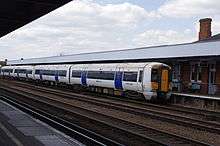 Southeastern Class 375/6 No. 375610 Royal Tunbridge Wells at Tonbridge in the former gold stripe livery (stripe was removed)
Southeastern Class 375/6 No. 375610 Royal Tunbridge Wells at Tonbridge in the former gold stripe livery (stripe was removed)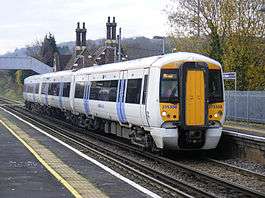 Southeastern Class 375/3 No. 375308 at Cuxton in their trial livery
Southeastern Class 375/3 No. 375308 at Cuxton in their trial livery.jpg) A pair of refurbished Class 375 No. 375810 and No. 375617 at Dover Priory
A pair of refurbished Class 375 No. 375810 and No. 375617 at Dover Priory The relocated and refurbished First Class cabin
The relocated and refurbished First Class cabin A half internal view of the refurbished Standard Class accommodation
A half internal view of the refurbished Standard Class accommodation
References
- 1 2 3 Bombardier Electrostar Family page Archived 10 October 2011 at the Wayback Machine.
- 1 2 "Southern Electrics Group". Archived from the original on 2 February 2014.
- ↑ Kent Rail Archived 3 April 2012 at the Wayback Machine.
- ↑ "One third of our trains start midlife refresh". Southeastern. 20 May 2015. Archived from the original on 31 May 2015. Retrieved 19 June 2015.
- ↑ "Station overrun at Stonegate, East Sussex" (PDF). Rail Accident Investigation Branch. 8 November 2010. Retrieved 23 April 2010.
- ↑ "Southeastern Train catches fire at Charing Cross Station". Rail Technology Magazine. Retrieved 5 January 2018.
- ↑ "Southeastern Train travelling between Chilham and Wye derails after hitting cattle". Kent Online. Kent Messenger Group. Retrieved 27 July 2015.
- ↑ "Derailment at Godmersham, Kent 26 July 2015" (PDF). Rail Accident Investigation Branch. Retrieved 6 April 2016.
Further reading
| Wikimedia Commons has media related to British Rail Class 375. |